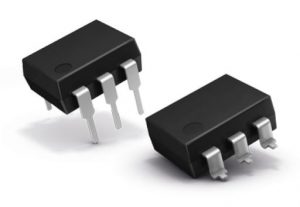Called AQV209G, it comes in through-hole and surface-mount versions and has a single ac-dc output with two mosfets that can be wired back-to-back series to switch ac (‘A’ connection), or in parallel to switch dc at higher current (‘C’ connection).
In this case, the abs max voltage rating is 1,200V peak ac or dc (960V peak recommended), then 750mA in ac configuration (1Ω typ, 2Ω max) or 1.4A in parallel dc configuration (250mΩ typ 500mΩ max). One-shot abs max peak current for 100ms is 2.25A, and up to 600mW can be handled at the output (650mW including input).
 The above figures, apart from the 650mW, are with the recommended 10mA through the two series-connected input LEDs (2.95Vf typ, 3.4V max – and 30mA max). Input is galvanically separate from output structures with 1,500Vrms isolation.
The above figures, apart from the 650mW, are with the recommended 10mA through the two series-connected input LEDs (2.95Vf typ, 3.4V max – and 30mA max). Input is galvanically separate from output structures with 1,500Vrms isolation.
Switching is bounce-free and typically turn-on takes 500μs (1ms max) and turn off 50μs (500μs max) – all at 10mA in and 100mA + 100V out.
Interestingly, the data sheet put maximum operating frequency at 2.5 ‘cps’ (50% duty, max load current and voltage) which seems a little slow if this is cycles/s – Electronics Weekly has asked for clarification. My guess is power dissipation during the transitions.
Size is 8.8 x 6.4 x 3.9mm and operation is over -40 to +85°C with some derating above 25°C. The timing figures and the resistances above are at 25°C.
